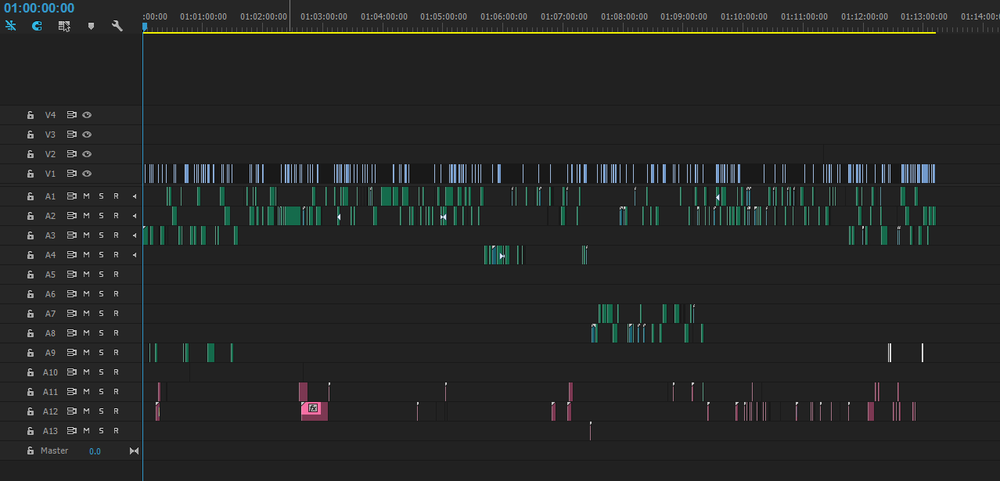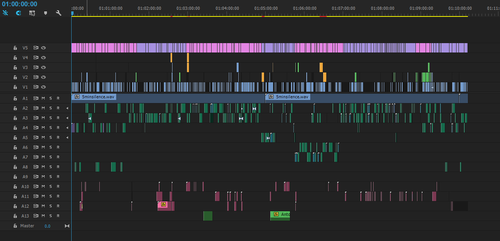For several years now, the Twitter editing community have been doing #TimelineTuesday - in which you screengrab the timeline of the project you're currently working on, and share it with the other editors. To us, it's an interesting look at the way other people set up their timelines, and some pretty big editors have joined in in the past, sharing various reels of major feature films with varying degrees of VFX and sound work.
I appear to be one of the few people sharing animation timelines, and they're quite different to what most other people are used to seeing. Indeed, they're quite different to my own live-action timelines (a comparison briefly discussed as part of Avid's own #TimelineTuesday series).
So, I'm going to show how I get there. What the various stages are, and a brief explanation where possible of what's changed and why. A previous blog post has a flow chart which shows the 'typical' route through the edit of an episode, for reference to how each part sits in the whole.
I'm using an episode from the series I'm currently editing as an example, and this post covers the animatic stage of production (for additional information see "editing an animatic", a previous blog post based on a different series). For animatics, I use Adobe's Premiere Pro.
v01 - first assembly
This is the version that my assistant/ trainee puts together. The 1045 storyboard panels we received for this episode are aligned with the audio, and some sound effects are added. The level of detail at this stage will usually depend on how our schedule's looking. This was during a busy period, and the episode was very over-length (we're working on 10 minute episodes, plus 1 minute start/end credits), so it's rather more sparse than some episodes would be - especially since we know that a sizeable chunk is going to be removed soon.
Speech is organised by character, one per track. We have a standard order/ track designation for each of the 10 characters that we deal with in this series, and then remove the unused tracks as we see which aren't needed. But the track for our fairy should always be below the dragon and squirrel, and above the goblin.
 Colour coding:
Colour coding:
Video Iris (blue) = storyboard panelsAudio Caribbean (green) = audio recorded to script
Audio Cerulean = walla library - useful audio nabbed from previously recorded episodes (such as effort grunts, laughter, gasps, and common speech like "yes", "aha", and character-specific exclamations)
Audio Rose = temp sfx. These are added from various libraries on our network, and usually replaced entirely by the sound post-production once the episode is locked.
-
v02 - first version out of the edit room
This is my first pass at the animatic, as the lead editor. Additional sfx and walla has been added, dialogue has been chopped up and separated in places, joined together in others, and replaced with other takes elsewhere. Empty audio tracks have been removed, and additional layers for sfx have been created. Mostly layers above V1 represent a partial image from a different board being super-imposed, but sometimes I add them to keep track of my thinking process or keep a handy record of another version. Similarly, dis-enabled audio clips may start to appear and be moved to an adjacent audio track as different takes start to be used.
For this episode I sent the animatic to the series and episode directors at quite an early stage, as I had a lot of questions and things that I wanted to verify before removing sections. Making sure that everyone is trying to tell the same story is an important (and useful) part of the editing job, and in animation there can be a lot of potential for looking at the same thing and seeing something completely different, especially at animatic stage.
Other questions regarded inconsistencies and suggested resolutions, unclear points and how we could fix those, and "would anyone be heartbroken if we lost [scene]?"
 Additional colour coding:
Additional colour coding:
Video Mango (orange) = effects - adjustment layers, texts containing notes, etc. Audio Violet = check for another take/ be prepared to add to pick-up sheet if this doesn't feel right as time goes on.
-
v03 - version to client
This version is put together aiming for a running time of approximately 10:15. I like to have a little more than the final 10 minutes to play with as some shots will inevitably change durations during animation - and needing to find extra time at the end (often involving additional animation) is a lot more difficult and time-consuming than cutting it out. At the same time though, we don't want too much of an over-shoot on the running time, as those 15 seconds represent up to a day's extra work on an already tight animation schedule.
It's important to get close to the proper duration before it goes to the client, to give the best representation of what the episode will include - having already made the key decisions about what's most important to the story, and also to demonstrate that the episode will work.
The notes from the previous stage involved a lot of manipulation of the panels in certain places - this is why I like to use Premiere at this stage, to quickly move parts of panels around and utilise adjustment layers over several panels to create a continuous movement/ single shot adjustment.We also had new storyboards made up for a few key moments - I like to add these to a different video track to keep the reference to the older version - but I colour them differently to show that they're replacing what's underneath rather than adding to the layers.
There is also a lot of further work of the same nature as described in v02 - additional and replacement sfx, dialogue manipulations and overlaps, requested alternative takes, etc.
 Additional colour coding:
Additional colour coding:
Video Forest (light green) = new storyboardsAudio Forest = temp music
-
v04 - post-client notes on animatic, prep for animation
This is where any notes from the client (broadcaster, creator) and additional notes from directors are incorporated. Some takes are swapped out, some shots lengthened or shortened... this one was actually fairly light on the number of comments that needed to be done in the edit, most of the notes were questions and suggestions for the animation stage - and lamenting the moments we'd lost (with the understanding that the overall running time was a factor).
When exporting for animation, the first stage is to number every shot in the lower left corner - that's the new video layer (V5) on the timeline. I like to alternate the colour of the labels, so that I can see where the scene breaks are (depending on the episode, I'll sometimes colour the boards themselves to show separate storylines - but even then the scene breaks in the numbering are helpful once the storylines converge) . Colour coding the scenes is handy for updating the animation, but also to get an overview of the structure of the episode. The structure of the shots within the scenes also come out clearly - with some action-heavy sequences or moments often denoted by longer shot durations. You may also note that the duration of any given set of storyboards isn't necessarily linked to the overall shot duration - action may be played out across the same shot, or across multiple different shots using different framing to give the energy - it all depends on the context of the story at that time, and the amount of movement or nuance required to convey meaning. This is just one reason why editing continues throughout animation - the amount of movement and energy and information within any moment is constantly changing, and the way an audience will react changes correspondingly.
A1, my '5minsilence.wav', is a Premiere-related quirk... when exporting a .wav for the animators (they take it into their animation software and set a start time and duration for each shot from the .xml metadata provided), points in the timeline without any audio can sometimes result in a nasty electronic noise 'filler'. Putting in a recording of some 'studio silence' helps to eliminate that.
This track will be used in later stages for the audio which comes in attached to the animation, at which point the silent audio will no longer be needed.
Additional track colour coding:
Video Lavender (pink) = shot numbers for odd-numbered scenes (text burn-in)
Video Violet = shot numbers for even-numbered scenes (text burn-in)
-
Next: the stages of the timeline through animation



